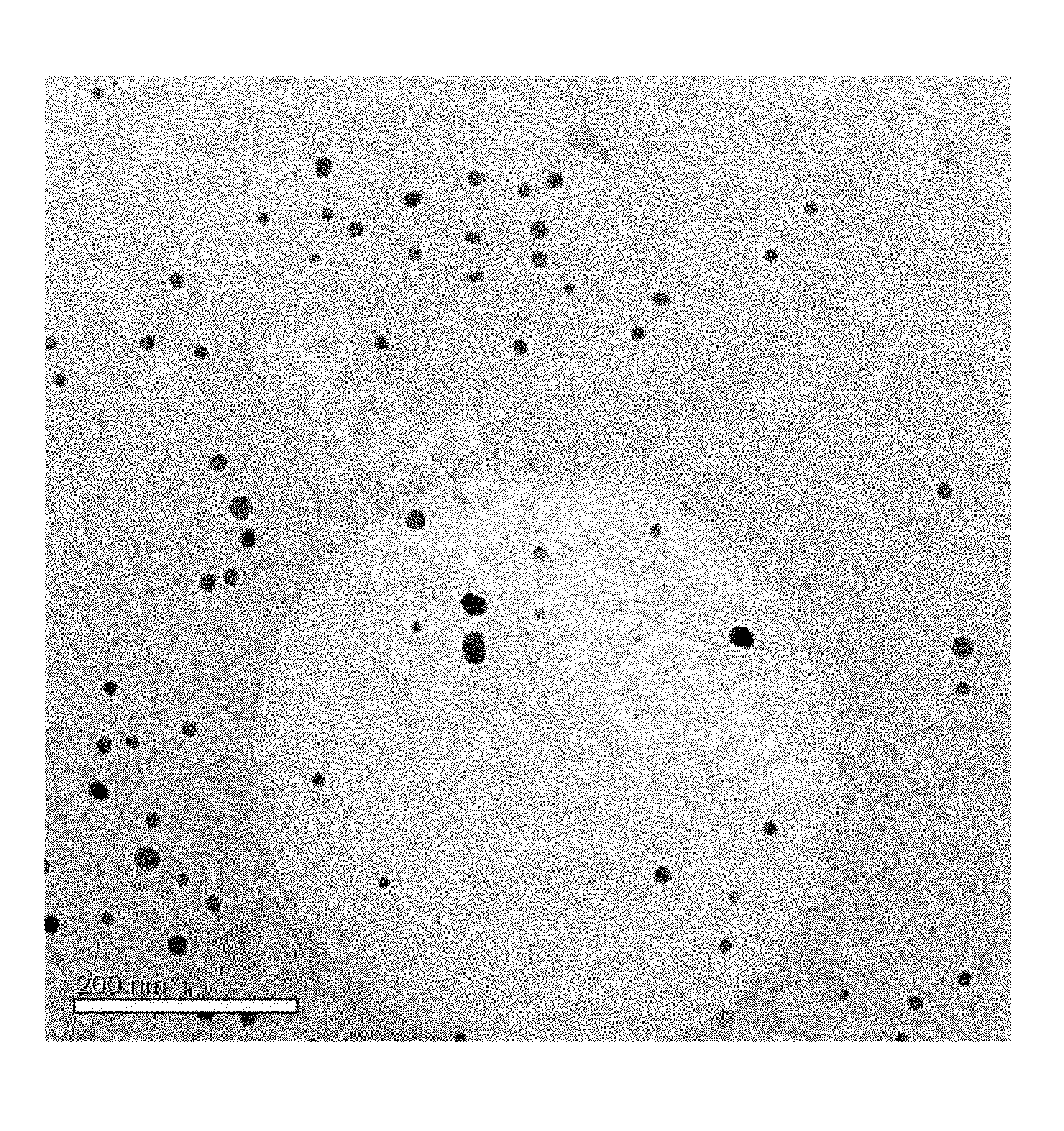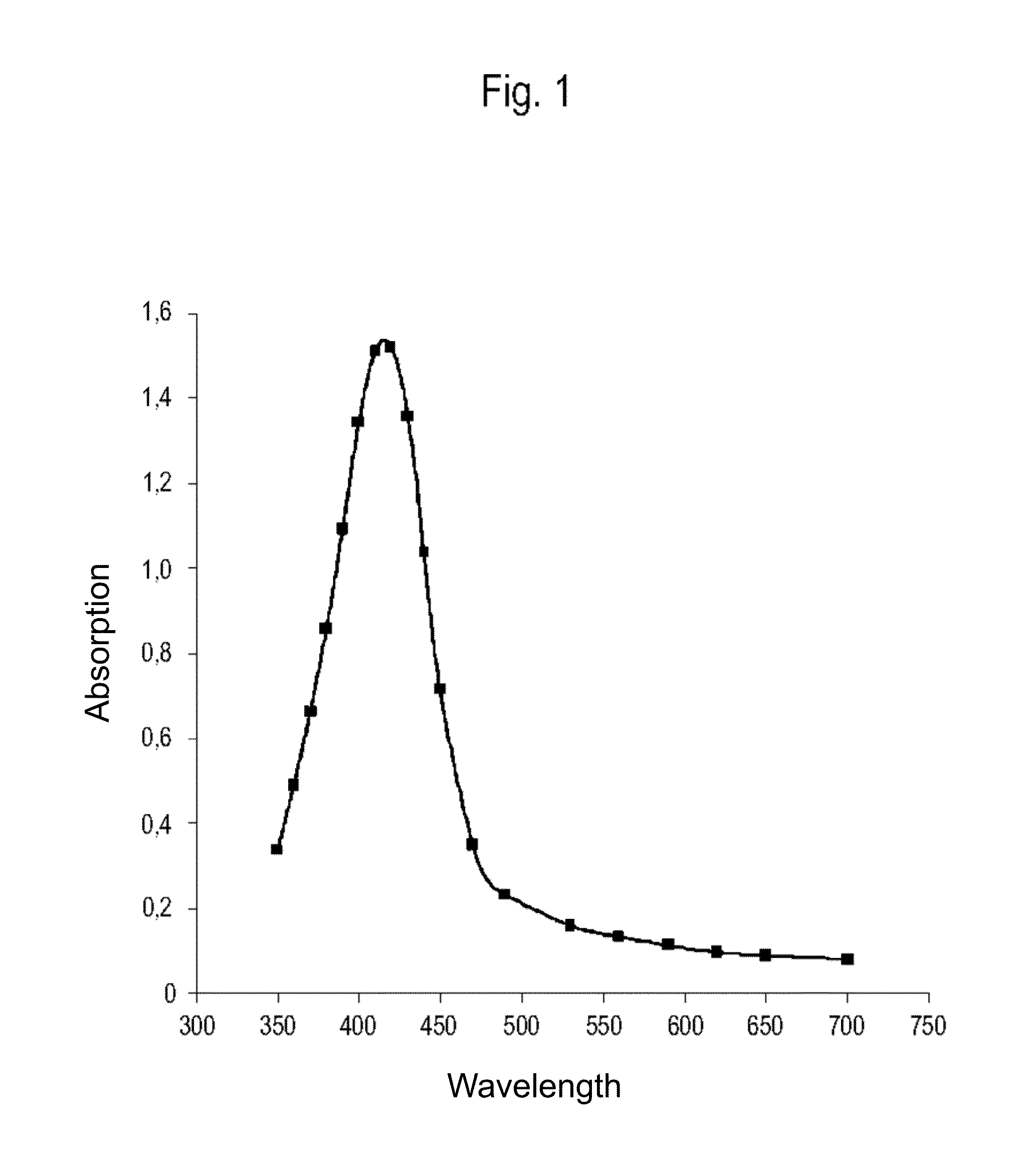Method for Producing a Dispersion Containing Silver Nanoparticles and Use of a Mixture Containing Silver Nanoparticles as a Coating Agent
- Summary
- Abstract
- Description
- Claims
- Application Information
AI Technical Summary
Benefits of technology
Problems solved by technology
Method used
Image
Examples
example 1
Formulation of Nanosilver with Hydrazine Hydrate, Ammonia, Tagat TO V™, and Tween20
[0146]A total of 7,000 g silver nitrate, 1,760 g Tagat TO V™, 1,760 g Tween20™, and 512 g hydrazine hydrate were placed in 28,439 g de-ionised water. The solution was stirred for 3 hours. Then, 5,000 g ammonia solution (14%) were added continuously as droplets over a period of 24 hours. The reaction was complete once the addition was completed and yielded a dispersion having a silver content of 10.0 wt.-%. The particle size and distribution were determined by means of a UV-VIS spectrum (FIG. 1). According to the results, a 10-percent nanosilver dispersion having a nanosilver particle size of 1-30 nm was obtained.
[0147]The absorption spectrum was taken on an aqueous solution, diluted 5,000-fold, that contains 20 ppm nanosilver, is clear, and deep-yellow in colour. The UV-VIS spectrum was recorded in the wavelength range of 750 to 350 nm. The absorption values measured showed a peak with a maximum at 41...
example 2
Formulation of Nanosilver with Hydrazine Hydrate, Ammonia, and Tagat TO V™
[0150]A total of 7,000 g silver nitrate, 3,520 g Tagat TO V™, and 1,331 g hydrazine hydrate were placed in 27,620 g de-ionised water. The solution was stirred for 3 hours. Then, 5,000 g ammonia solution (14%) were added continuously as droplets over a period of 24 hours. The reaction was complete once the addition was completed and yielded a dispersion having a silver content of 10.0 wt.-%. The particle size and distribution were determined by means of a UV-VIS spectrum. According to the results, a 10-percent nanosilver dispersion having a nanosilver particle size of 1-30 nm was obtained.
example 3
Formulation of Nanosilver with Hydrazine Hydrate, Potassium Hydrogencarbonate, Tagat TO V™, and Tween80™
[0151]A total of 7,000 g silver nitrate, 2,360 g Tagat TO V™, 1,160 g Tween20™, and 1,331 g hydrazine sulfate were placed in 27,620 g de-ionised water. The solution was stirred for 3 hours. Then, 5,000 g potassium hydrogencarbonate solution (1,900 g KHCO3) were added continuously as droplets over a period of 30 hours. The reaction was complete once the addition was completed and yielded a dispersion having a silver content of 10.0 wt.-%. The particle size and distribution were determined by means of a UV-VIS spectrum (FIG. 1). According to the results, a 10-percent nanosilver dispersion having a nanosilver particle size of 1-30 nm was obtained.
PUM
| Property | Measurement | Unit |
|---|---|---|
| Time | aaaaa | aaaaa |
| Percent by mass | aaaaa | aaaaa |
| Percent by mass | aaaaa | aaaaa |
Abstract
Description
Claims
Application Information
 Login to View More
Login to View More - R&D
- Intellectual Property
- Life Sciences
- Materials
- Tech Scout
- Unparalleled Data Quality
- Higher Quality Content
- 60% Fewer Hallucinations
Browse by: Latest US Patents, China's latest patents, Technical Efficacy Thesaurus, Application Domain, Technology Topic, Popular Technical Reports.
© 2025 PatSnap. All rights reserved.Legal|Privacy policy|Modern Slavery Act Transparency Statement|Sitemap|About US| Contact US: help@patsnap.com



